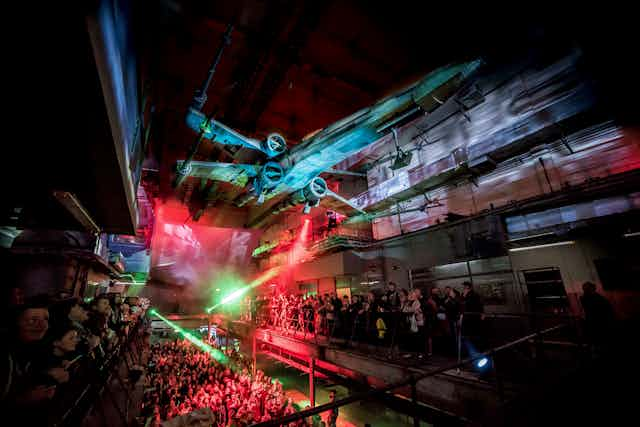The soon-to-be-released Star Wars: Episode VII – The Force Awakens is tipped to be the box office success of 2015. Hardly surprising given that fans have been waiting ten years since the last installment.
A lot has changed in how films are produced and promoted in the intervening decade. Last summer, for example, there was a huge Secret Cinema Star Wars event. Their immersive The Empire Strikes Back experience sold a staggering 100,000 tickets, generating over £6 million at the box office.
Running over four months, the event brought to the fore a new form of immersive cinematic entertainment which exploded in the UK over the summer of 2015. In addition to Secret Cinema’s event, the largest season of Open Air Cinema concluded its 125 outdoor screening run. In fact, a dizzying number of organisations now turn cinema into events: in the UK these include Sneaky Experience, Floating Cinema, Sing-alonga, Rooftop Film Club and Nomad Cinema.
There is a growing trend toward cinema-as-event – where film screenings are augmented by synchronous live performance, site-specific locations, technological interventions, social media engagement, and all manner of simultaneous interaction including singing, dancing, eating, drinking, even smelling.

This summer also saw the UK tour of a live re-scoring of George Lucas’s 1971 film THX 1138 by Asian Dub Foundation. A unique score was composed by the band and played live alongside the film’s screening, interwoven with the film’s original soundtrack. This is one of the first times this has been done in this way: re-scorings are usually performed to silent and foreign language films (where it isn’t crucial for an English-speaking audience to hear the original soundtrack due to subtitles).
The last performance of the tour was attended by sound designer Walter Murch, who said afterwards: “It’s like being the author of a 19th century novel who then sees that novel being turned into an opera.”
Walter’s presence at the event signalled that live cinema has passed a landmark moment. These events have become mainstream, achieving significant box office success and commercial gain. They have also been accepted by the film industry as a normalised part of the distribution and development of a film. As a matter of course, decisions in Hollywood as to whether there will be a live distribution strategy are made from the outset.

Shifting grounds
So why are we seeing such a sudden change in the way that film is consumed?
Technologically, the industry has burgeoned as a result of the rapid advancement of “pop-up” screen technology (such as inflatable screens and directional audio). This enables screenings to take place in locations that have previously been inaccessible, such as Hampton Court Palace, Kew Gardens or an obscure warehouse rooftop.
In commercial terms, we might compare the film industry’s need to branch out to that of the music industry. Both are facing threats to traditional forms of revenue generation due to the easy access offered by the internet. So both have turned their attention to the attraction of live events as an alternative. The film industry has also expanded in response to the public’s love for nostalgia and the power of fan engagement – many events tend to revolve around “old” and well-loved film releases; Secret Cinema’s Back to the Future was one such example last year.

The rise in events also dovetails with the rise in social media. Individuals have a growing need to populate their social media streams with novel and exciting experiences.
Artistically, this new form also offers audiences a deeper emotional engagement with films. Murch recalled a moment of anticipating these latent possibilities during the 1971 scoring session for THX 1138:
It was electrifying to see a film energised by 80 musicians recording that music, and I thought at the time, and this was 45 years ago, wouldn’t it be great to allow ordinary people to experience this.
The future of film
Live cinema events are not just new ways of experiencing film. The trend is also likely to direct the development of film itself. Early cinema history shows that new forms of exhibition and audience engagement drove the evolution of new film genres and techniques.
For example, the 1908 explosion of Nickelodeon movie theatres in the USA led to the creation of the fiction film and film studio in order to provide a constant flow of viewing fodder for the masses cheaply and efficiently. Likewise, the 1950s rise of drive-in cinema culture spawned the teen-movie genre in order to fill the double and triple bills that the audiences demanded.

The current growth of live cinema exhibition and distribution will surely have the same impact today. Certain films are chosen and promoted because of characteristics which make them suitable for this kind of exhibition.
THX 1138 worked because of its sparse dialogue, meaning that the live music could be woven in effectively, still enabling the audiences to hear the dialogue and original sound score. The Empire Strikes Back screening and pre-event build-up was infused with the theme of rebellion and secrecy, which was germane to the film’s original narrative, ensuring the audience’s willingness to engage in the experience, purchasing costumes from the pop-up and online shops, and bringing along props as instructed.
In the future, genre conventions and production practices and processes will respond directly to the “live” model in the development and production phases. Film aesthetics, style and process will evolve as a result, and we are likely to see films being made specifically for live exhibition –- which will take increasingly spectacular forms.

